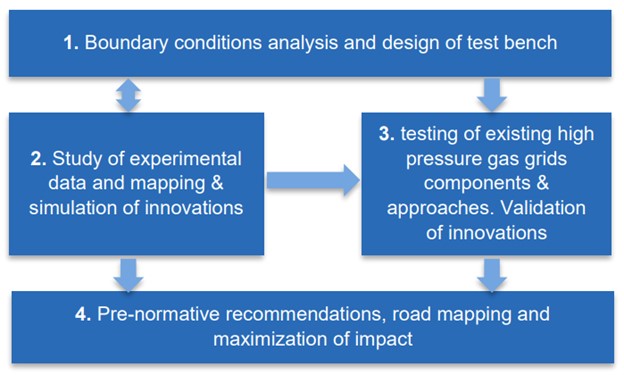Research project
HIGGS – Hydrogen in Gas Grids
The HIGGS project aims to show that the safe injection of hydrogen into the EU high pressure transmission natural gas grid is a sustainable, long-term solution to decarbonise the energy system. HIGGS is going to identify remaining weaknesses regarding H2-Readiness and develop a pathway for a stepwise integration of hydrogen in the EU gas network.
Main objective
The main objective of the HIGGS project is to cover the gaps of knowledge of the impact that high levels of hydrogen could have on the gas infrastructure, its components and its management. The main tasks within the project:
- Mapping of technical, legal and regulatory barriers and enablers for up to 100% H2 in the high-pressure grid
- Set up and operate a research and development platform reproducing all the components of a high-pressure network
- Testing and validating different accessories, appliances and innovations for various H2/CH4 admixtures
- Techno-economic modelling for H2/CH4 admixtures within the high-pressure grid and equipment (Work package lead at OST)
Expected main results
The main findings and assessments compiled in the project will be merged in the form of a document that describes a pathway to enable higher concentrations of hydrogen in the natural gas transmission grid. This pathway, among other things, will include a list of potential issues, barriers and facilitators for cross-border and interoperability in the gas grids, recommendations on regulations codes and standards, a summary of the recommendations for admixture and injection facilities as well as Gas market and operation considerations.
Mapping of Key Aspects
In order to achieve the set goals, the HIGGS project team is collection information on various key aspects regarding the integration of hydrogen in the high-pressure EU gas grid. Special emphasis is put on taking up on legal, regulatory and technical aspects by mapping the present equipment, as well as regulations, standards and certification (RSC) of the natural gas grids. The identification of the most critical RSC bottlenecks will not only enable end users and operators to work the entire gas grid safely but also help to prevent the replacement of fully operable equipment and appliances due to rising hydrogen concentrations in the gas grid.
Systematic and experimental validation
The biggest concern for safety when admixing hydrogen into the natural gas grid is related to materials detrition and embrittlement. The HIGGS project is going to target this issue by mapping the existing materials used in the gas networks, defining a laboratory test protocol to study them and finally provide recommendations for those materials to be used in high pressure hydrogen mixtures. To be able to carry out those tests on materials and the impact of transporting high amounts of hydrogen through the gas grid the HIGGS team is designing an experimental R&D platform that will be built in 2021. The site is composed of an injection platform that recreates the different flows of H2 with various compositions, a testing loop that is designed to work up to 80 bar and includes the main components needed to recreate the operational environment of a high-pressure gas grid and a hydrogen purification prototype that is based on membrane technology for the separation of H2 and CH4.
This project has received funding from the Fuel Cells and Hydrogen 2 Joint Undertaking (FCH JU) under grant agreement no. 875091. This Joint Undertaking receives support from the European Union’s Horizon 2020 research and innovation program, Hydrogen Europe and Hydrogen Europe research.
Duration: 01.01.2020 - 31.12.2022
Partner:
FHa Foundation for the development of Hydrogen Technologies in Aragon, ERIG European Research Institute for Gas and Energy Innovation, DVGW Deutsche Verein des Gas- und Wasserfaches e.V., Redexis S.A., Tecnalia
Team:
Salvatore Oricchio
IET Institut für EnergietechnikFachbereichsleitung Power-to-X
+41 58 257 43 32salvatore.oricchio@ost.ch

Christoph Steiner
IET Institut für EnergietechnikWissenschaftlicher Mitarbeiter
+41 58 257 43 49christoph.steiner@ost.ch




